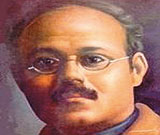Gadar means “mutiny”, "revolt" and was the name of the publication of the Hindustan Association of the Pacific Coast which was formed in May, 1913, in Astoria, Oregon, with the objective of liberating India from British colonialism. Lala Har Dayal who had been a faculty member at Stanford University, California, was the central figure and the force behind the newly formed organization. He became the General Secretary of the association while Sohan Singh Bhakna was elected President and Kanshi Ram as Treasurer.
At the dawn of the twentieth century, Indian emigrants started coming to the United States and Canada. Several immigrants were retirees from the British Indian army but most of them were uneducated farmers or unskilled workers from Punjab. The new immigrants were willing to do any kind of manual job and found work in lumber mills or as farm hands. By 1908, the number of Indian immigrants in Canada had reached about 5000. The white workers got alarmed that competition from Indian laborers would displace them from their jobs and bring wages down. They demanded exclusionary laws against the cheap foreign workers. Their festering hostility and pent-up frustrations manifested in violence against the Indian immigrants. In 1909, severe immigration restrictions virtually ended legal Asian emigration to Canada. In the United States too, prejudice, bigotry, racial riots, lead to the passage of exclusionary and other laws and in 1917, Asian emigration to the United States was also stopped.
Higher education in American universities was a powerful magnet for young people and several Indian students had joined various American universities. However, upon graduation, they were not able to get jobs commensurate with their qualifications. They attributed American employers discriminatory practices to their being nationals of a subjugated country. They formed organizations to collectively assert their birthright for independence for India and started fostering feelings of patriotism and nationalism among Punjabi laborers who were also disillusioned facing hostility and racial prejudice from the American people. When the Hindustan Association of the Pacific Coast was formed, Punjabi laborers supported its objectives whole-heartedly, became its members enthusiastically and supported it financially.
The headquarters of Hindustan Association of the Pacific Coast was established in San Francisco where a building was purchased with funds raised from the community. The association began publishing a magazine,
Gadar, to expose the British imperialism and called upon the Indian people to unite and rise up against the British rule. It carried articles on the conditions of the people of India under British Rule and also on problems of racial attacks and discrimination against Indians in the USA and Canada. The publication
Gadar, over a period of time, became well known among Indians and the Hindustan Association of the Pacific Coast itself became known as the Gadar party.
| Gadar literature was sent to Indian revolutionaries in India, Europe, Canada and several other countries. The British government used every means to stop the circulation of Gadar and other such publications, particularly in India. The magazine, being the principal patriotic literature, reached many people; even if one copy reached a fellow revolutionary anywhere, multiple copies were made for circulation. |

Lala Har Dayal |
Hindustan Association was barely a few months old when under pressure from the British Indian Government, Har Dyal was arrested by the U.S. Government. He was released on bail on March 24, 1914 but soon left for Switzerland and then to Germany. The sudden departure of Har Dyal did create some vacuum in the organizational structure of the association but the committed volunteers continued to work tirelessly and pursued their objective without interruption.
About a year after the formation of the Hindustan Association, World War I broke out in August, 1914, in which Germany fought against England. The German government and the Gadarites had the British as common enemy, so Germany offered the Indian Nationalists (Gadarites) financial aid to buy arms and ammunitions to expel the British from India while the British Indian troops were busy fighting war at the front. The Gadarites started a vigorous campaign to exhort the overseas Indians to join the freedom movement and encouraged them to go to India to launch a revolution. They drew plans to infiltrate the Indian army and excite the soldiers to fight against the British Empire and free India from the shackles of British imperialism. With funding from the German government, several ships were chartered to carry arms and ammunition to India. About 6000 overseas Indians hurried homeward to join revolutionaries in India and liberate their motherland.
The traitors of the movement leaked out the secret plan to the British spies. The ships carrying arms and ammunition never reached India. Many gadarites and revolutionaries were taken captive upon reaching India. Several Gadarites were imprisoned, many for life, and some were hanged. In the United States too, many Gadarites and Germans who supported Gadar activities, were prosecuted and some were incarcerated for varying terms of imprisonment. Some gadarites who escaped arrests, including Kartar Singh Sarabha and Vishnu Govind Pingle, made alliance with revolutionaries in India. But they could not get the support of Mahatma Gandhi and other leaders of India’s Freedom movement, who had already committed to support the British Indian Government. What an irony; while the gadarites had gone to India to fight willingly for the freedom of their motherland, the Indian leadership openly and willingly co-operated with the British.
The Gadarites had a flame of liberty lit in their hearts, and did not hesitate to make any sacrifice for the cause of freedom and liberty of their motherland. Although the movement did not achieve its stated objective, but it awakened the sleeping India and left a major impact on India’s struggle for freedom. The heroism, courage and sacrifices of the Gadarites inspired many freedom fighters who eventually saw India freed from the British imperialism in 1947.
|